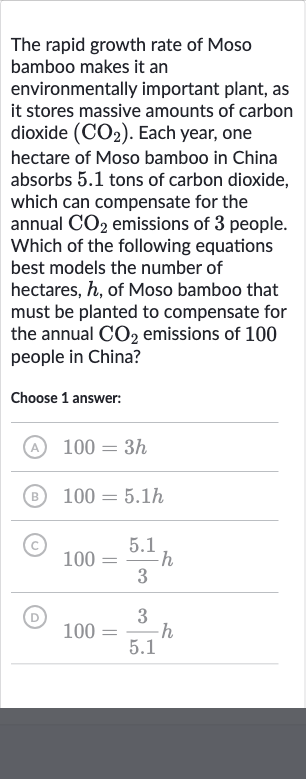AI tutor
Welcome to Bytelearn!
Let’s check out your problem:

The rapid growth rate of Moso bamboo makes it an environmentally important plant, as it stores massive amounts of carbon dioxide . Each year, one hectare of Moso bamboo in China absorbs . tons of carbon dioxide, which can compensate for the annual emissions of people. Which of the following equations best models the number of hectares, , of Moso bamboo that must be planted to compensate for the annual emissions of people in China?Choose answer:(A) (B) (C) (D)
Full solution
Q. The rapid growth rate of Moso bamboo makes it an environmentally important plant, as it stores massive amounts of carbon dioxide . Each year, one hectare of Moso bamboo in China absorbs . tons of carbon dioxide, which can compensate for the annual emissions of people. Which of the following equations best models the number of hectares, , of Moso bamboo that must be planted to compensate for the annual emissions of people in China?Choose answer:(A) (B) (C) (D)
- CO absorption rate: One hectare of Moso bamboo absorbs tons of CO annually, which compensates for the emissions of people. To find the number of hectares needed to compensate for people, we need to set up a proportion.
- Setting up the equation: Let be the number of hectares needed to compensate for the CO emissions of people. Since hectare compensates for people, we can write the equation as: people hectare people hectares
- Finding the ratio: To find , we need to set up a ratio that compares the number of people to the number of hectares. The ratio is:
- Solving for h: Cross-multiply to solve for h:
- Final equation: The equation that models the number of hectares needed to compensate for the CO emissions of people is . Therefore, the correct answer is (A) .
